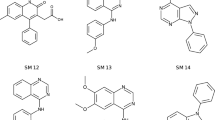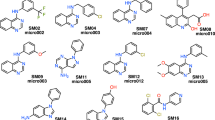Abstract
We report the performance of a classical density functional theory (CDFT) in the competition for the solvation free-energy category of the SAMPL4 blind prediction event. The theoretical calculations were carried out with the TIP3P water model and different combinations of solute configurations and molecular force fields. In comparison with the experimental data, the blind test yields an average unsigned error of 2.38 kcal/mol and the root mean square deviation of 2.99 kcal/mol. Whereas these numbers are significantly larger than the best results from explicit-solvent MD simulations, we find that the theoretical performance is sensitive to both the molecular force fields and solute configurations and that a comparable level of accuracy can be achieved by a judicious selection of the solute configurations and the force-field parameters. Most importantly, CDFT reduces the computational cost of MD simulation by almost 3 orders of magnitude, making it very attractive for large-scale hydration free-energy calculations (e.g., screening the aqueous solubility of drug-like molecules).


Similar content being viewed by others
References
Chipot C, Pohorille A (2007) In: Study (ed) Free energy calculations: theory and applications in chemistry and biology. Springer, New York
Hirata F (ed) (2003) Molecular theory of solvation. Kluwer Academic Publishers, Dordrecht
Ellingson BA, Geballe MT, Wlodek S, Bayly CI, Skillman AG, Nicholls A (2014) J Comput Aided Mol Des. doi:10.1007/s10822-014-9720-8
Hawkins GD, Lynch GC, Chambers CC, Storer JW, Li J, Thompson JD, Winget P, Rinaldi D, Liotard DA, Cramer CJ, Truhlar DG (2003) AMSOL-version 7.0. University of Minnesota, Minneapolis
Cramer CJ, Truhlar DG (1999) Chem Rev 99(8):2161
Roux B, Simonson T (1999) Biophys Chem 78(1–2):1
Wu J, Li Z (2007) Annu Rev Phys Chem 58:85
Singer SJ, Chandler D (1985) Mol Phys 55(3):621
Kinoshita M, Okamoto Y, Hirata F (1997) J Comput Chem 18(10):1320
Liu Y, Zhao S, Wu J (2013) J Chem Theory Comput 9(4):1896
Mobley DL, Wymer KL, Lin NM, Guthrie JP (2014) J Comput Aided Mol Des. doi:10.1007/s10822-014-9718-2
Guthrie JP (2014) J Comput Aided Mol Des. doi:10.1007/s10822-014-9738-y
Liu Y, Fu J, Wu J (2013) J Phys Chem Lett 4(21):3687
Jorgensen WL, Chandrasekhar J, Madura JD, Impey RW, Klein ML (1983) J Chem Phys 79(2):926
Wang J, Wolf RM, Caldwell JW, Kollman PA, Case DA (2004) J Comput Chem 25(9):1157
Jorgensen WL, Maxwell DS, Tirado-Rives J (1996) J Am Chem Soc 118(45):11225
Jakalian A, Jack DB, Bayly CI (2002) J Comput Chem 23(16):1623
Breneman CM, Wiberg KB (1990) J Comput Chem 11(3):361
Brooks BR, Bruccoleri RE, Olafson BD, States DJ, Swaminathan S, Karplus M (1983) J Comput Chem 4(2):187
Frisch MJ, Schlegel HB, Scuseria GE, Robb MA, Cheeseman JR, Scalmani G, Barone V, Mennucci B, Petersson GA, Nakatsuji H, Caricato M, Li X, Hratchian HP, Izmaylov AF, Bloino J, Zheng G, Sonnenberg JL, Hada M, Ehara M, Toyota K, Fukuda R, Hasegawa J, Ishida M, Nakajima T, Honda Y, Kitao O, Nakai H, Vreven T, Montgomery Jr. JA, Peralta JE, Ogliaro F, Bearpark M, Heyd JJ, Brothers E, Kudin KN, Staroverov VN, Kobayashi R, Normand J,.Raghavachari K, Rendell A, Burant JC, Iyengar SS, Tomasi J, Cossi M, Rega N, Millam JM, Klene M, Knox JE, Cross JB, Bakken V, Adamo C, Jaramillo J, Gomperts R, Stratmann RE, Yazyev O, Austin AJ, Cammi R, Pomelli C, Ochterski JW, Martin RL, Morokuma K, Zakrzewski VG, Voth GA, Salvador P, Dannenberg JJ, Dapprich S, Daniels AD, Farkas Ö, Foresman JB, Ortiz JV, Cioslowski J, Fox DJ (2009) Gaussian 09, revision D.01. Gaussian, Inc, Wallingford, CT
Van Der Spoel D, Lindahl E, Hess B, Groenhof G, Mark AE, Berendsen HJC (2005) J Comput Chem 26(16):1701
Scalmani G, Frisch MJ (2010) J Chem Phys 132(11):114110
Acknowledgments
This research is sponsored in part by the Department of Energy (DE-FG02-06ER46296) and the National Science Foundation (NSF-CBET-0852353).
Author information
Authors and Affiliations
Corresponding author
Electronic supplementary material
Below is the link to the electronic supplementary material.
Rights and permissions
About this article
Cite this article
Fu, J., Liu, Y. & Wu, J. Fast prediction of hydration free energies for SAMPL4 blind test from a classical density functional theory. J Comput Aided Mol Des 28, 299–304 (2014). https://doi.org/10.1007/s10822-014-9730-6
Received:
Accepted:
Published:
Issue Date:
DOI: https://doi.org/10.1007/s10822-014-9730-6




